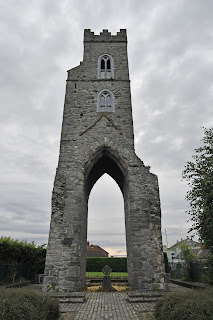Ireland: Day 8 – County Louth
My plans for my last day in Ireland came together in a very ad hoc fashion. Having seen everything I wanted to see, I searched for interesting sights close to the highway between Dublin and Belfast. These did not include – though I found it the most interesting sight of all – the modest highway sign saying “Welcome to Northern Ireland” painted over with several streaks of dark red paint.
My first stop was in
Drogheda, which I assume should be pronounced with a guttural “gh” that most
English-speakers can’t make. The city is home to multiple interesting
buildings: the almost completely ruined Saint Mary Magdalene Friary, Saint
Laurence’s Gate, and Millmount Fort. Of these, the friary is perhaps the most
unusual: the part that remains is a singular gothic arch supporting two
windowed stories. Its tallness gives the structure a very fragile look, but it
is precisely this part of the building that was the most long-lived.
From Drogheda, I drove
around twenty minutes to Mainistir Bhuithe (or Monasterboice). The site was
completely deserted when I arrived, which I found rather strange considering
its proximity to Dublin and its significance: it has the tallest high cross in
Ireland, as well as Muiredach’s High Cross – considered to be the finest
high cross in Ireland. The graveyard on which it stands is also home to a
somewhat derelict round tower, bringing my round tower tally to six (or over
nine per cent of all the round towers in Ireland).
Despite the continuous
rain, which occasionally tapered off into a soft drizzle, I continued with the
agenda and made a short stop at Ardee, home to the “largest fortified medieval
tower house in Ireland.” The next stop came half an hour later at Proleek.
Right next to the village’s golf course (and within sight of signs warning
visitors of stray balls) are two stone-age monuments: a dolmen and a wedge
tomb. Legend connects these to the giant Fionn mac Cumhaill, who was challenged
to a fight by Scottish giant Para Buidhe Mór Mhac Seoidin. The Scot carried the
dolmen to its present location but drank from a river poisoned by Fionn and was
subsequently buried in the “giant’s tomb.”
Not much later, I
seamlessly crossed into Northern Ireland, filled up the gas tank, and returned
the car to the dealership at Belfast International. Flagging down a taxi, I
then transported myself to Belfast City. When I was paying, I briefly forgot
that I had to use Pounds rather than Euros – a mistake that seemed to annoy the
driver to an inordinate extent.













Comments
Post a Comment